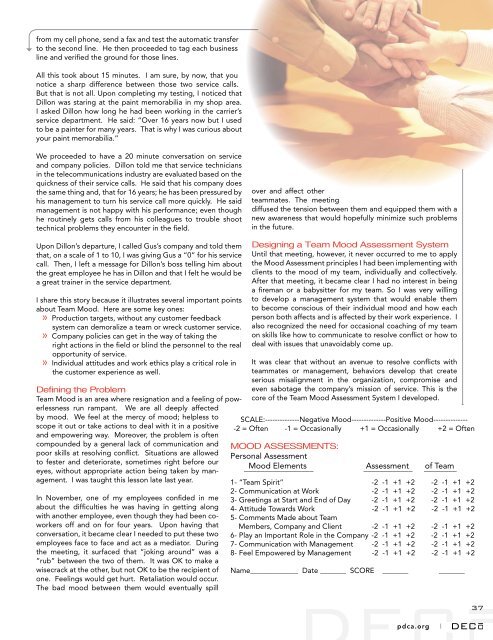n o v/d e c • 2 0 0 8 - Subscribe
n o v/d e c • 2 0 0 8 - Subscribe
n o v/d e c • 2 0 0 8 - Subscribe
Create successful ePaper yourself
Turn your PDF publications into a flip-book with our unique Google optimized e-Paper software.
from my cell phone, send a fax and test the automatic transfer<br />
to the second line. He then proceeded to tag each business<br />
line and verified the ground for those lines.<br />
All this took about 15 minutes. I am sure, by now, that you<br />
notice a sharp difference between those two service calls.<br />
But that is not all. Upon completing my testing, I noticed that<br />
Dillon was staring at the paint memorabilia in my shop area.<br />
I asked Dillon how long he had been working in the carrier’s<br />
service department. He said: “Over 16 years now but I used<br />
to be a painter for many years. That is why I was curious about<br />
your paint memorabilia.”<br />
We proceeded to have a 20 minute conversation on service<br />
and company policies. Dillon told me that service technicians<br />
in the telecommunications industry are evaluated based on the<br />
quickness of their service calls. He said that his company does<br />
the same thing and, that for 16 years; he has been pressured by<br />
his management to turn his service call more quickly. He said<br />
management is not happy with his performance; even though<br />
he routinely gets calls from his colleagues to trouble shoot<br />
technical problems they encounter in the field.<br />
Upon Dillon’s departure, I called Gus’s company and told them<br />
that, on a scale of 1 to 10, I was giving Gus a “0” for his service<br />
call. Then, I left a message for Dillon’s boss telling him about<br />
the great employee he has in Dillon and that I felt he would be<br />
a great trainer in the service department.<br />
I share this story because it illustrates several important points<br />
about Team Mood. Here are some key ones:<br />
» Production targets, without any customer feedback<br />
system can demoralize a team or wreck customer service.<br />
» Company policies can get in the way of taking the<br />
right actions in the field or blind the personnel to the real<br />
opportunity of service.<br />
» Individual attitudes and work ethics play a critical role in<br />
the customer experience as well.<br />
Defining the Problem<br />
Team Mood is an area where resignation and a feeling of powerlessness<br />
run rampant. We are all deeply affected<br />
by mood. We feel at the mercy of mood; helpless to<br />
scope it out or take actions to deal with it in a positive<br />
and empowering way. Moreover, the problem is often<br />
compounded by a general lack of communication and<br />
poor skills at resolving conflict. Situations are allowed<br />
to fester and deteriorate, sometimes right before our<br />
eyes, without appropriate action being taken by management.<br />
I was taught this lesson late last year.<br />
In November, one of my employees confided in me<br />
about the difficulties he was having in getting along<br />
with another employee, even though they had been coworkers<br />
off and on for four years. Upon having that<br />
conversation, it became clear I needed to put these two<br />
employees face to face and act as a mediator. During<br />
the meeting, it surfaced that “joking around” was a<br />
“rub” between the two of them. It was OK to make a<br />
wisecrack at the other, but not OK to be the recipient of<br />
one. Feelings would get hurt. Retaliation would occur.<br />
The bad mood between them would eventually spill<br />
over and affect other<br />
teammates. The meeting<br />
diffused the tension between them and equipped them with a<br />
new awareness that would hopefully minimize such problems<br />
in the future.<br />
Designing a Team Mood Assessment System<br />
Until that meeting, however, it never occurred to me to apply<br />
the Mood Assessment principles I had been implementing with<br />
clients to the mood of my team, individually and collectively.<br />
After that meeting, it became clear I had no interest in being<br />
a fireman or a babysitter for my team. So I was very willing<br />
to develop a management system that would enable them<br />
to become conscious of their individual mood and how each<br />
person both affects and is affected by their work experience. I<br />
also recognized the need for occasional coaching of my team<br />
on skills like how to communicate to resolve conflict or how to<br />
deal with issues that unavoidably come up.<br />
It was clear that without an avenue to resolve conflicts with<br />
teammates or management, behaviors develop that create<br />
serious misalignment in the organization, compromise and<br />
even sabotage the company’s mission of service. This is the<br />
core of the Team Mood Assessment System I developed.<br />
SCALE:--------------Negative Mood--------------Positive Mood--------------<br />
-2 = Often -1 = Occasionally +1 = Occasionally +2 = Often<br />
MOOD ASSESSMENTS:<br />
Personal Assessment<br />
Mood Elements Assessment of Team<br />
_________________ ____________ ________<br />
1- “Team Spirit” -2 -1 +1 +2 -2 -1 +1 +2<br />
2- Communication at Work -2 -1 +1 +2 -2 -1 +1 +2<br />
3- Greetings at Start and End of Day -2 -1 +1 +2 -2 -1 +1 +2<br />
4- Attitude Towards Work -2 -1 +1 +2 -2 -1 +1 +2<br />
5- Comments Made about Team<br />
Members, Company and Client -2 -1 +1 +2 -2 -1 +1 +2<br />
6- Play an Important Role in the Company -2 -1 +1 +2 -2 -1 +1 +2<br />
7- Communication with Management -2 -1 +1 +2 -2 -1 +1 +2<br />
8- Feel Empowered by Management -2 -1 +1 +2 -2 -1 +1 +2<br />
Name_____________ Date _______ SCORE _______ _______<br />
pdca.org |<br />
37








